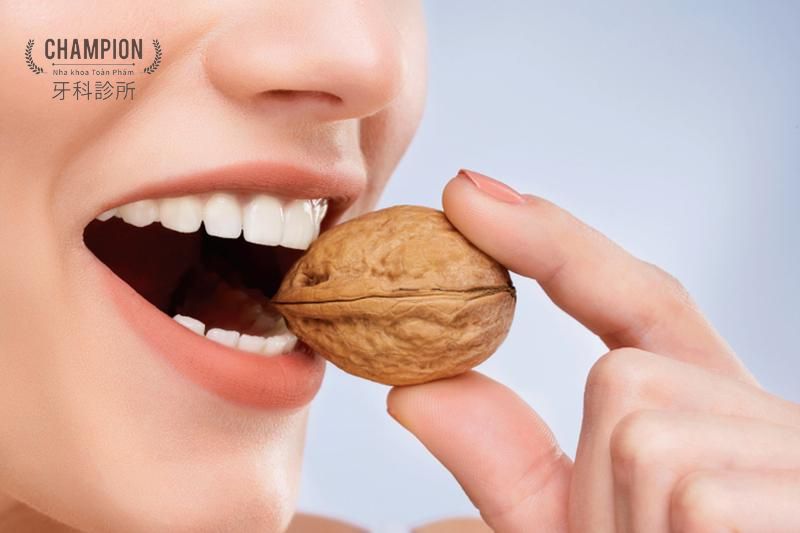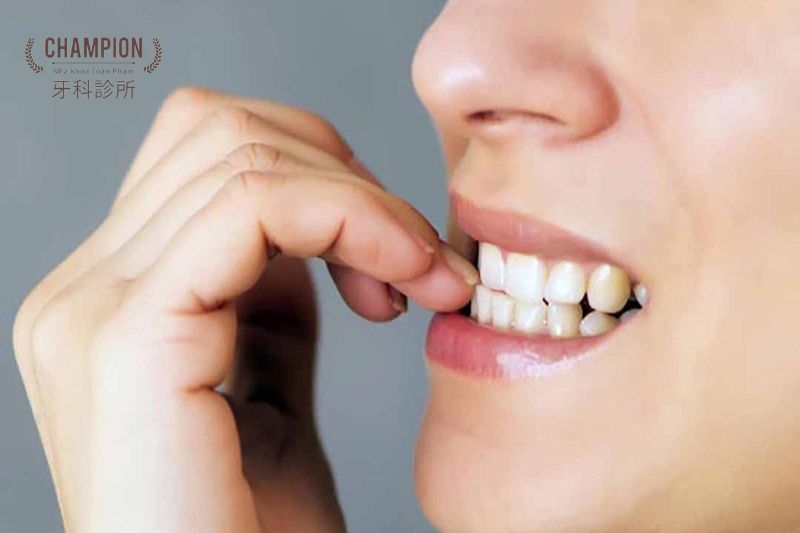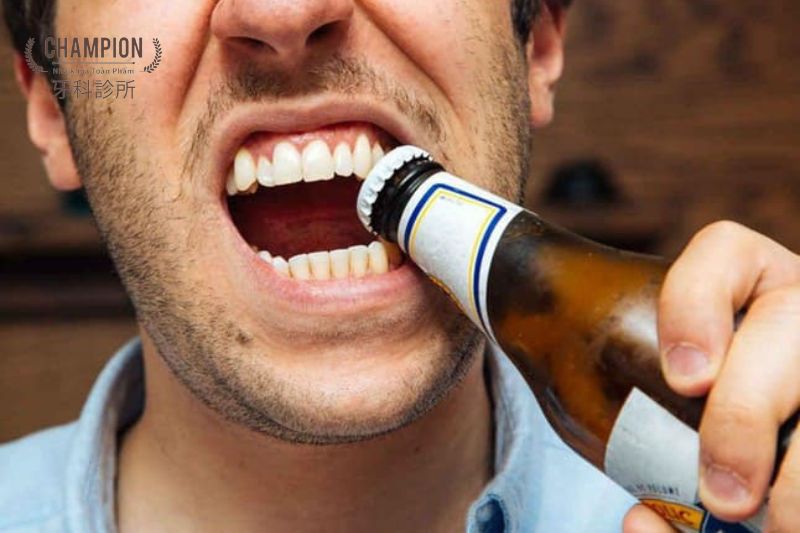In everyday life, using teeth to bite or chew hard objects like hard candy, ice, nuts, etc., is not uncommon. However, this action can lead to cracked teeth, a serious issue that affects your dental health. In this article, let's explore in more detail the condition of cracked teeth due to biting hard objects with Champion Dental Clinic!
Tooth Structure and Pressure
Our teeth are composed of three main layers: enamel, dentin, and pulp. The enamel is the outermost and hardest layer, protecting the inner layers from external environmental impacts. However, even being the hardest substance in the body, enamel has its limits in withstanding pressure. When biting into hard objects, the sudden pressure can exceed the enamel's threshold, leading to cracked teeth.
- Enamel: This is the hard outer shell that protects the inner dentin from harmful agents. Enamel does not have regenerative cells, so once damaged, it cannot be restored.
- Dentin: Located beneath the enamel, this layer contains numerous cells and blood vessels, supplying nutrients to the tooth.
- Pulp: This is the central part of the tooth, containing nerves and blood vessels.
Causes of Tooth Cracking When Biting Hard Objects
Teeth can crack for the following reasons when biting into hard objects:
- Sudden pressure: When biting into a hard object, sudden pressure is applied to a small point on the tooth's surface, and the enamel cannot disperse the force quickly, leading to chips or breaks.
- Nature of the hard object: Hard materials like hard candy, ice, or nuts can exert greater pressure than what the enamel can withstand.
- Pre-existing weaknesses: If a tooth already has issues like cavities or pre-existing cracks, its structure is weakened, and biting hard objects increases the risk of cracking.
- Teeth grinding habit: Grinding not only puts pressure on the teeth but also weakens their structure, making them more susceptible to cracking when biting into hard objects.

How to Handle a Cracked Tooth Due to Biting Hard Objects
When a tooth cracks due to biting into a hard object, the most important thing is to stay calm and handle the situation carefully to avoid further damage. Here are some steps you can take at home before seeing a dentist:
Spit out broken tooth pieces
If a tooth breaks, try to spit out or cough up the fragments from your mouth. This helps avoid the risk of the fragments injuring the gums or soft tissue in the mouth and prevents the possibility of swallowing them.
Avoid touching the cracked tooth with your hands or tongue
Do not touch or probe the cracked part of the tooth with your hands or tongue as it could cause further damage or lead to infection. Instead, place a clean cotton ball on the broken area and gently bite down to protect the tooth.
Preserve the broken tooth pieces
Keep any broken pieces (if possible) and store them in a sealed container with milk or saliva. This could be helpful for later treatment at the dentist's office.
Gently rinse your mouth
Rinse your mouth gently with saltwater to clean the broken area and reduce the risk of infection. Then, apply a new cotton ball to keep the area clean.
Cover sharp tooth edges
If you can't see a dentist right away, use dental wax or sugar-free gum to temporarily cover any sharp edges of the tooth, preventing injury to the tongue and soft tissues in the mouth.
Be careful with food and drink
Choose soft foods and avoid chewing with the part of the jaw that has the broken tooth. Limit foods that are too spicy, sour, cold, or hot to avoid irritating the tooth.
Visit a dentist
Schedule an appointment with a dentist as soon as possible. The dentist will assess the situation and suggest appropriate treatment options, ranging from fillings and crowns to root canal treatment if necessary.

>> See more: Effective ways to prevent tooth chipping from experts
Treatment Methods for Cracked Teeth Due to Biting Hard Objects
When a tooth is cracked or chipped, choosing the appropriate treatment method is crucial not only to restore the tooth's shape and function but also to protect long-term oral health. Here are the details of each treatment method:
Tooth Reshaping and Polishing
In cases where a tooth is only chipped with a small piece that doesn't affect the tooth's main structure, the dentist might choose to smooth the chipped edge and then polish it. This procedure helps remove any sharp edges that could injure the soft tissues in the mouth, and restores the smoothness of the tooth surface, bringing the tooth back to its near-original aesthetic and functional state.
Dental Filling
For teeth that are cracked but not severely, the dentist may suggest filling the crack. This process involves thoroughly cleaning the crack and then using filling materials such as dental composite (a specialized dental plastic) or silver amalgam to fill it in. This filling helps prevent bacteria and food from entering the crack, thereby minimizing the risk of infection, decay, and other issues.
Reattaching Broken Pieces
When a large part of the tooth is broken off but hasn't exposed the pulp or affected the root, the dentist might proceed to bond the broken piece back. The prerequisite is that the broken pieces must be well-preserved, not decayed, and intact. The dentist will use specialized dental adhesive to bond the broken piece back to the remaining tooth, helping to restore the tooth's shape and partially its function.
Tooth Extraction and New Tooth Restoration
In situations where the tooth is severely broken, such as a large break that exposes the pulp or causes serious damage beyond repair, the dentist might consider extracting the tooth. After extraction, there are several options for restoring a new tooth, such as dental bridges, removable dentures, or dental implants.
Each option has its own advantages and limitations, depending on the overall oral health status, needs, and preferences of the patient.

Conclusion
Cracked teeth from biting hard objects can affect both the aesthetics and the chewing function. Therefore, timely treatment and prevention are very important. If you experience a cracked tooth, be sure to visit Champion Dental Clinic for a timely examination and treatment!
Vietnamese & English: (028) 5411-2295
中文: (028) 5411-2297 172 Nguyen Luong Bang, Tan Phu Ward, District 7, Ho Chi Minh City.
Fanpage: Champion Dental Clinic 牙科診所
Zalo: Champion Dental Clinic
Youtube: Champion Dental Clinic 牙科診所
 Champion Dental Clinic
Champion Dental Clinic



